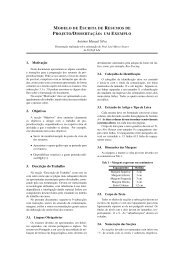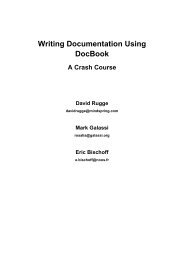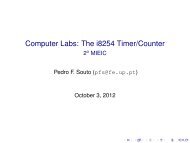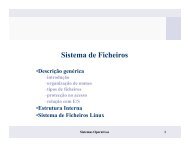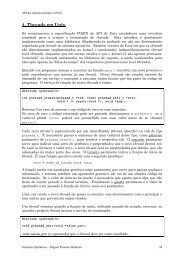You also want an ePaper? Increase the reach of your titles
YUMPU automatically turns print PDFs into web optimized ePapers that Google loves.
<strong>Computer</strong> <strong>Labs</strong>: <strong>The</strong> <strong>PC</strong> <strong>Keyboard</strong>2 o MIEICPedro F. Souto (pfs@fe.up.pt)October 7, 2011
<strong>PC</strong> <strong>Keyboard</strong> Operation (1/2)IRQ1<strong>Keyboard</strong>i8042(KBC)OUT_PORTIN_PORTSTAT_REGIN_BUFOUT_BUF0x640x60I/O bus◮ <strong>The</strong> keyboard has its own controller chip (not shown): thecontroller@KBD (C@KBD)◮ When a key is pressed the C@KBD generates a scancode(make code) and puts it in a buffer for sending to the <strong>PC</strong>◮ Usually, a scancode is one byte long◮ <strong>The</strong> same happens when a key is released◮ Usually, the scancode when a key is released (break code)is the make code of that key with the MSB set to 1◮ <strong>The</strong> communication between the C@KBD and the <strong>PC</strong> isvia a serial line◮ I.e. the bits in a byte are sent one after the other over a pairof wires
<strong>PC</strong> <strong>Keyboard</strong> Operation (2/2)IRQ1<strong>Keyboard</strong>i8042(KBC)OUT_PORTIN_PORTSTAT_REGIN_BUFOUT_BUF0x640x60I/O bus◮ On the <strong>PC</strong> side this communication is managed by thekeyboard controller (KBC)◮ In modern <strong>PC</strong>s, the KBC is integrated in the motherboardchipset◮ When OUT_BUF is empty:1. <strong>The</strong> KBC signals that via the serial bus2. <strong>The</strong> C@KBD sends the byte at the head of its buffer to theKBC3. <strong>The</strong> KBC puts it in the OUT_BUF4. <strong>The</strong> KBC generates an interrupt by raising IRQ1
<strong>Keyboard</strong> Interrupt Handler (IH)◮ Needs to read only the byte in the KBC’s OUT_BUF◮ Communication between the keyboard and the KBC israther slow◮ IHs should be as fast as possible◮ ... and, of course, to output an EOI to the PIC◮ Conversion from a scancode to a character code (ASCII orsome other code) should not be done in the IH◮ IHs should be kept to a minimum◮ Note that some scancodes may be more than 1 byte long◮ But again, this can be taken care of outside the IH◮ It is possible to operate the KBC in polling mode, but it isnot very convenient◮ Why?
<strong>Keyboard</strong> Commands (1/2)◮ In the early <strong>PC</strong> models, interface with the keyboard used avery simple IC at port 0x60◮ For compatibility, the KBC provides two registers at thatport:IN_BUF i.e. Input BufferOUT_BUF i.e. Output Bufferand emulates the old interface:1. <strong>The</strong> KBC forwards bytes (commands) written in theIN_BUF to the C@KBD2. <strong>The</strong> C@KBD responds with one of 3 values:0xFA (ACK), 0xFE (Resend) or 0xFC (Error)3. <strong>The</strong> KBC puts the response in the OUT_BUF and raisesIRQ1Note <strong>The</strong> names of the registers IN_BUF/OUT_BUF are fromthe point of view of the KBC. <strong>The</strong> processor:◮ Writes to the IN_BUF◮ Read from the OUT_BUF
<strong>Keyboard</strong> Commands (2/2)Command Meaning Args0xFF Reset KBD0xF6 Set default values and enable KBD0xF5 Disable KBD0xF4 Clear buffer and enable KBD0xF3 Change KBD repetition rate/delay bits 0-4 ratebits 5-6 delay0xED Switch on/off KBD LEDs bits 0-2Note <strong>The</strong> arguments of commands that require them have tobe written to the IN_BUF too, and are also acknowledged◮ <strong>The</strong> C@KBD responds with one of 3 values as above.Thus issuing such a command, requires 4 steps:1. Write command to the IN_BUF2. Read KBD response from the OUT_BUF3. Write argument to the IN_BUF4. Read KBD response from the OUT_BUFIn the case the KBD response is:Resend (0xFE) the last byte should be written againError (0xFC) the entire sequence should be restarted
Command 0xF3 (Configure Typematic Parameters)◮ Is an operating mode in which the keyboard generates astream of scancodes when the user holds a key down◮ <strong>The</strong> KBD allows to configure this operation via:Delay Which specifies the delay for entering typematicmode, counted from the moment the user presses downthe key;Rate Which specifies the rate at which scancodes aregenerated, once the keyboard switches to typematicmode.Command 0xED (Set KBD LEDs)Bit 2 Caps Lock indicatorBit 1 Numeric Lock indicatorBit 0 Scroll lock indicator◮ <strong>The</strong>re is no way to read the value of these LEDs◮ <strong>The</strong> code that changes them should remember their state
<strong>The</strong> KBC Commands (of the <strong>PC</strong>-AT)◮ <strong>The</strong> KBC added a few commands, the KBC commands,and two new registers at port 0x64STAT_REG: for reading the KBC stateNot named for writing KBC commands◮ Apparently, this is not different from the IN_BUF at port0x60◮ <strong>The</strong> value of input line A2 is used by the KBC todistinguish KBC commands from KBD commands◮ That is: the KBC has only one writable register, theIN_BUF
STAT_REG◮ Input from/output to KBC requires reading the STAT_REGBit Name Meaning (if set)7 Parity Parity error - invalid data6 Timeout Timeout error - invalid data5 Aux Mouse data4 INH Inhibit flag: 0 if keyboard is inhibited3 A2 A2 input line: 0 data byte1 command byte2 SYS System flag: 0 if system in power-on reset,1 if system already initialized1 IBF Input buffer fulldon’t write commands or arguments0 OBF Output buffer full - data available for reading◮ Bits 7 and 6 signal an error in the serial communication linebetween the keyboard and the KBC◮ Do not write to the INPUT_BUF, if bit 1, i.e. the IBF, is set.
<strong>Keyboard</strong>-Related KBC Commands for <strong>PC</strong>-AT/PS2◮ <strong>The</strong>se commands must be written using address 0x64◮ Arguments, if any, must be passed using address 0x60◮ Return values, if any, are passed in the OUT_BUFCommand Meaning Args (A)/ Return (R)0x20 Read Command Byte Returns Command Byte0x60 Write Command Byte0xAA Check KBC (Self-test) Returns 0x55, if OKReturns 0xFC, if error0xAB Check <strong>Keyboard</strong> Interface Returns 0, if OK0xAD Disable KBD Interface Inhibits KBD from sending data0xAE Enable KBD Interface◮ <strong>The</strong>re are several others related to the mouse
(KBC “Command Byte”)7 6 5 4 3 2 1 0– – DIS2 DIS – – INT2 INTDIS2 1: disable mouseDIS 1: disable keyboardINT2 1: enable interrupt on OBF, from mouse;INT 1: enable interrupt on OBF, from keyboard- : Either not used or not relevantRead Use KBC command 0x20, which must be written to 0x64Write Use KBC command 0x60, which must be written to 0x64
Issuing a Command to the KBC#define STAT_REG 0x64#define KBC_CMD_REG 0x64while( 1 ) {sys_inb(STAT_REG, &stat); /* assuming it returns OK *//* loop while 8042 input buffer is not empty */if( (stat & IBF) == 0 ) {sys_outb(KBC_CMD_REG, cmd); /* no args command */return 0;}delay(WAIT_KBC);}Note 1 Cannot output to the KBC_CMD_REG while the inputbuffer is fullNote 2 Code leaves the loop only when it succeeds to outputthe data to the KBC_CMD_REG◮ To make your code resilient to failures in theKBC/keyboard, it should give up after “enough time” forthe KBC to send a previous command/data to the KBD.
Reading Return Value/Data from the KBCwhile( 1 ) {sys_inb(STAT_REG, &stat); /* assuming it returns OK *//* loop while 8042 output buffer is empty */if( stat & OBF ) {sys_inb(OUT_BUF, &data); /* assuming it returns OK}if ( (stat &(PAR_ERR | TO_ERR)) == 0 )return data;elsereturn -1;}delay(WAIT_KBC);Note 1 Code leaves the loop only upon some input from theOUT_BUF.◮ It is not robust against failures in the KBC/keyboardNote 2 Must mask IRQ1, otherwise the keyboard IH may runbefore we are able to read the OUT_BUF
KBC Programming IssuesInterrupts If the command have responses, and interrupts areenabled, the IH will “steal” them away from other code◮ <strong>The</strong> simplest approach is just to disable interrupts.Timing KBD/KBC responses are not immediate.◮ Code needs to wait for long enough, but not indefinitelyConcurrent Execution <strong>The</strong> C@KBD continuously scans theKBD and may send scancodes, while your code is writingcommands to the KBC:◮ How can you prevent accepting a scancode as aresponse to a command?◮ It is easier to solve this for KBC commands than for KBDcommands.
Further Reading◮ IBM’s Functional Specification of the 8042 <strong>Keyboard</strong>Controller (IBM <strong>PC</strong> Technical Reference Manual)◮ W83C42 Data Sheet, Data sheet of an 8042-compatibleKBC◮ Adam Chapweske’s <strong>The</strong> AT-PS/2 <strong>Keyboard</strong> Interface◮ Andries Brouwer’s <strong>The</strong> AT keyboard controller, Ch. 11 of<strong>Keyboard</strong> scancodes◮ Andries Brouwer’s <strong>Keyboard</strong> commands, Ch. 12 of<strong>Keyboard</strong> scancodes◮ Randal Hyde’s <strong>The</strong> <strong>PC</strong> <strong>Keyboard</strong>, Ch. 20 of the Art ofAssembly Language



